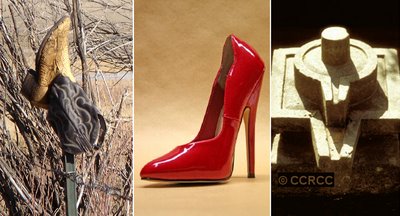
Photos above: left, Asher'ah, detail from an ivory box from Minat al-Bayda' near Ras Shamra, Syria, c. 1300bce; in the Louvre, Paris; right, Astarte, with Lotus blossum, Canaan, 3000-2000bce; Israel Museum(IDAM), Jerusalem - see John Singer Sargent's wonderful
Astarte in Boston Library.
Against who did the Yahwist prophets of the Hebrew Scriptures rail (Judges 6.25-32; 1 Kings 16.32,33, Ezekiel 8.1-18)? And what was her wooden aniconic image which they repeatedly "broke, cut, hewed, burned and uprooted" (2 Kings 23; 2 Chron 31.1,34.4,7)? First, the goddess - Part Two: The Object.
Drawing from the several citations in the hopefully "neutral" Encyclopædia Britannica , here is what we can easily learn of Asherah (aka- Astarte of Phoenicia, Ishtar of Akkadia, Inanna of Sumeria, Aphrodite of Cyprus, Hathor/Isis of Eygpt, cf:
Tara of present day Tibet ). (Why say "neutral"? - a] remember that history, as well as religions and law were written by yesterday's victors and that b] today's fundamentalist believers "of the Book[s]" still avoid any competitive mythos - then, it is best, if possible, to find neutral playing fields.)
From the EB: Asher'ah (or Ashtoreth) was an ancient West Semitic goddess and consort of the supreme god, El (cf: Beth-El). Her full name was probably "She Who Walks in the Sea," but she was also called "Holiness," and, occasionally, Elath, "the Goddess." According to the texts discovered at Ugarit (modern Ras Shamra, Syria) in 1929, by a French archaeological mission under the direction of Claude F.A. Schaeffer, Asher'ah was the mother of 70 gods by her consort, El. She is also called simply Qudshu, "Holiness." Asherah is associated with the sea and with serpents. As mother goddess she was widely worshiped throughout Syria and Palestine, although she was frequently paired with Baal, who often took the place of El in practical cult; as Baal's consort, Asherah was usually given the name Baalat.
Many Ugaritic texts reveal an older Canaanite mythology. A tablet names the Ugaritic pantheon with Babylonian equivalents; El, Asherah of the Sea, and Baal were the main deities. These texts not only constitute a literature of high standing and great originality but also have an important bearing on Old Testament studies. It is now evident that the patriarchal stories in the Old Testament were not merely transmitted orally but were based on written documents of Canaanite origin, the discovery of which at Ugarit has led to a new appraisal of the Old Testament.
According to the Hebrew Bible, Asherah and Astarte were both worshiped in Israel during the first half of the 1st millennium bce, and Hebrew inscriptions attest to a pairing of Yahweh and Asherah. Up to the time of King Josiah's reform (621 BC) there was a women's cult of Asherah (under qedeshim auspices [consecrated for fertility practices], according to 2 Kings 23:7) in the Jerusalem [ed: aka Solomon's] Temple. The qedsha was one of a class of sacred prostitutes found throughout the ancient Middle East, especially in the worship of the fertility goddess Astarte (Ashtoreth). These prostitutes, who often played an important part in official temple worship, could be either male or female. Although Israelite prophets and reformers repeatedly denounced sacred prostitution, the early Israelites seem to have adopted the local Canaanite rites, which they apparently practiced publicly until the reform of King Josiah about 622 BC.
Asherah's Hebrew devotees considered her the chief wife of Yahweh, even as she was the wife of El, head of the Canaanite pantheon, for in the Bible El is identified with Yahweh. But Josiah eliminated the cult of Asherah, and official Judaism has since then left no place for other gods, which meant the elimination of every goddess. Popular religion, to be sure, persisted in the female fertility principle until the destruction of the Temple in 586 BC. In Judaean excavations Astarte figurines were found in private homes down to that time. Further purification of the Hebrew religion, which was intensified by the catastrophe of 586, put an end to the practice of pagan fertility rites, including the use of goddess figurines. Without goddesses there could be no sexual activity in the pantheon, and thus Judaism has developed without a divine mother figure.
Copyright © 1994-2001 Encyclopædia Britannica, Inc.







